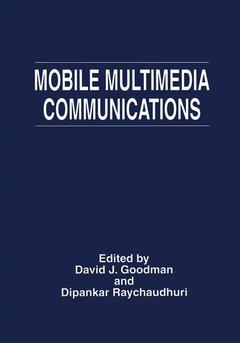Mobile Multimedia Communications, 1997
Langue : Anglais
Coordonnateurs : Goodman David J., Raychaudhuri Dipankar

In 1997, the two hottest topics in information technology are the Internet and mobile communications. Each one has the enthusiastic attention of the consuming public, investors. and the technical community. In a time of rapid expansion, they both face technical obstacles to meeting the public's high expectations. This situation stimulates a high volume of research in both areas. To bring the Internet into the twenty-first century. the research community focuses on multimedia communications in which integrated systems store, transport. and process many types of information simultaneously. A major challenge is to meet the of each information service. This problem is separate performance requirements especially challenging when a system has to deliver broadband, real-time services such as full-motion video. Meanwhile. the mobile communications research community continues its long term struggle against the triple challenge of mobility. ether. and energy. "Mobility" refers to the changing locations of terminals. When terminals are mobile. networks have to determine their locations and dynamically establish routes for information. The networks also have to rearrange themselves in order to maintain links to terminals with active communications sessions. "Ether" refers to the problems of wireless communications including limited bandwidth. rapidly changing radio propagation conditions. mutual interference of radio signals. and vulnerability of systems to eavesdropping and unauthorized access. "Energy" refers to the fact that portable information devices carry their own power sources. The rate at which the batteries of cellular telephones and portable computers drain their energy has a strong effect on their utility.
Networks: Limits and Challenges for Wireless ATM; E. Ayanoglu, et al. Wireless Intelligent ATM Network; F.-C. Cheng, J.M. Holtzman. An Active Network Architecture for ATM WANS; A.B. Kulkarni, et al. Forest Fire Monitoring Using a GSM Based System; F.M.S. Ramos, et al. Protocols. End-To-End Programmability for QOS Controlled Mobility in ATM Networks and Their Wireless Extension; A.T. Campbell. Loss Profiles at the Link Layer; K. Brown, S. Singh. Mobile-TCP: An Asymmetric Transport Protocol Design for Mobile Systems; Z.J. Haas. Media Access: Adaptive Packet Reservation Multiple Access (A-PRMA) for Broadband Wireless ATM; S. Norskov, et al. R-TDMA: A Dynamic Multiple Access Protocol Using Bandwidth on Demand and Priorities; G.R.J. Linnenbank, et al. Performance Evaluation of Reserved Idle Signal Multiple Access with Collision Resolution; F. Watanabe, et al. Signal Processing: Design Experience with an Integrated Testbed for Wireless Multimedia Computing; C. Chien, et al. Performance of Punctured Codes for Wireless ATM Networks; M. Barton, L.F. Chang. OFDM with Diversity and Coding for High-Bit-Rate Mobile Data Applications; L.J. Cimini, Jr., N.R. Sollenberger. 21 Additional Articles. Index.
Date de parution : 07-2013
Ouvrage de 312 p.
17.8x25.4 cm
Disponible chez l'éditeur (délai d'approvisionnement : 15 jours).
Prix indicatif 158,24 €
Ajouter au panier
© 2024 LAVOISIER S.A.S.



